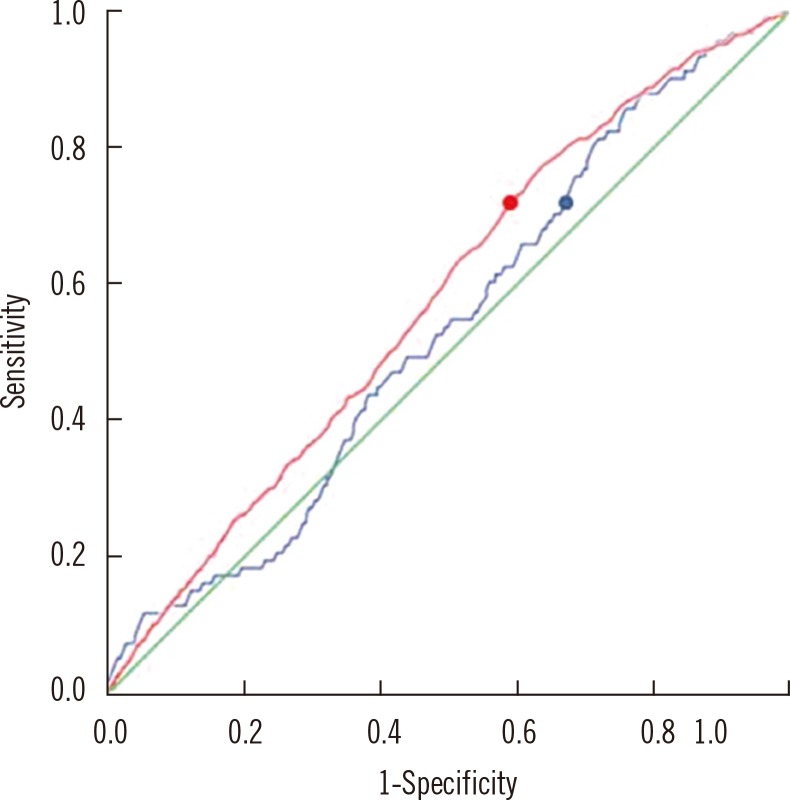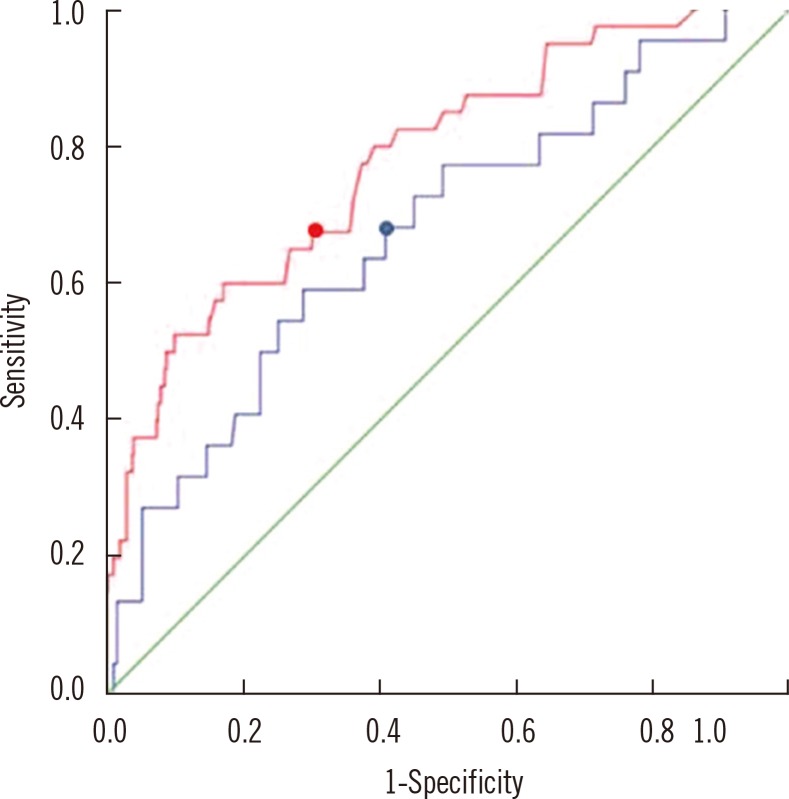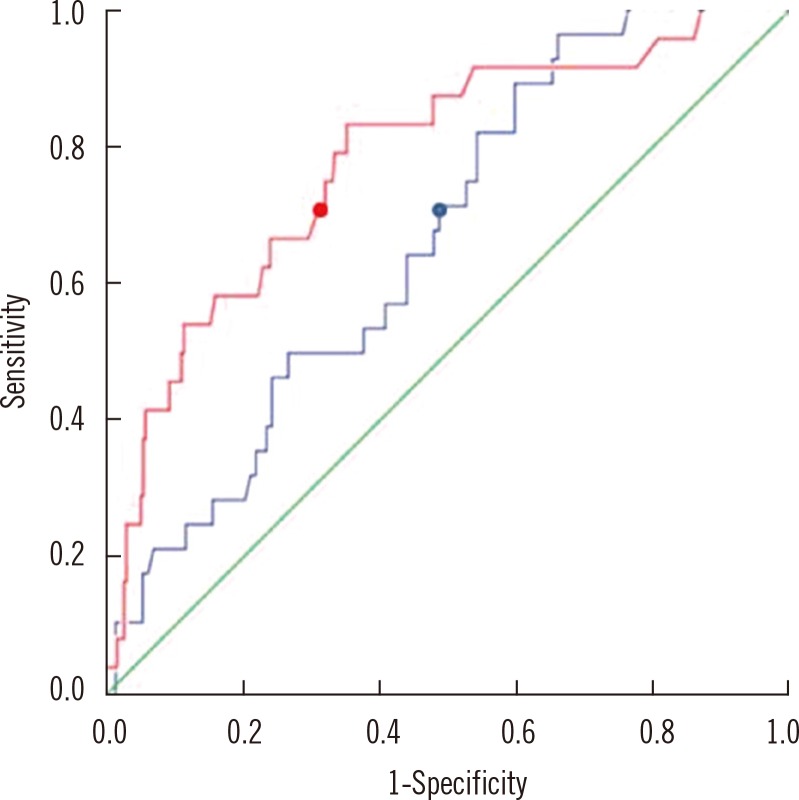Ann Lab Med.
2014 Sep;34(5):354-359. 10.3343/alm.2014.34.5.354.
Evaluation of the Optimal Neutrophil Gelatinase-Associated Lipocalin Value as a Screening Biomarker for Urinary Tract Infections in Children
- Affiliations
-
- 1Department of Laboratory Medicine, Chung-Ang University College of Medicine, Seoul, Korea. cpworld@cau.ac.kr
- 2Department of Pediatrics, Chung-Ang University College of Medicine, Seoul, Korea.
- 3Department of Urology, Chung-Ang University College of Medicine, Seoul, Korea.
- KMID: 1791949
- DOI: http://doi.org/10.3343/alm.2014.34.5.354
Abstract
- BACKGROUND
Neutrophil gelatinase-associated lipocalin (NGAL) is a promising biomarker in the detection of kidney injury. Early diagnosis of urinary tract infection (UTI), one of the most common infections in children, is important in order to avert long-term consequences. We assessed whether serum NGAL (sNGAL) or urine NGAL (uNGAL) would be reliable markers of UTI and evaluated the appropriate diagnostic cutoff value for the screening of UTI in children.
METHODS
A total of 812 urine specimens and 323 serum samples, collected from pediatric patients, were analyzed. UTI was diagnosed on the basis of culture results and symptoms reported by the patients. NGAL values were measured by using ELISA.
RESULTS
NGAL values were more elevated in the UTI cases than in the non-UTI cases, but the difference between the values were not statistically significant (P=0.190 for sNGAL and P=0.064 for uNGAL). The optimal diagnostic cutoff values of sNGAL and uNGAL for UTI screening were 65.25 ng/mL and 5.75 ng/mL, respectively.
CONCLUSIONS
We suggest that it is not appropriate to use NGAL as a marker for early diagnosis of UTI in children.
MeSH Terms
-
Acute-Phase Proteins/*urine
Area Under Curve
Biological Markers/blood/urine
Child
Child, Preschool
Early Diagnosis
Enzyme-Linked Immunosorbent Assay
Female
Humans
Infant
Lipocalins/*blood/*urine
Male
Mass Screening/*methods
Proto-Oncogene Proteins/*blood/*urine
ROC Curve
Urinary Tract Infections/*blood/*urine
Acute-Phase Proteins
Biological Markers
Lipocalins
Proto-Oncogene Proteins
Figure
Reference
-
1. Devarajan P. Review: neutrophil gelatinase-associated lipocalin: a troponin-like biomarker for human acute kidney injury. Nephrology. 2010; 15:419–428. PMID: 20609093.
Article2. Fjaertoft G, Foucard T, Xu S, Venqe P. Human neutrophil lipocalin (HNL) as a diagnostic tool in children with acute infections: a study of the kinetics. Acta Paediatr. 2005; 94:661–666.
Article3. Ichino M, Kuroyanagi Y, Kusaka M, Mori T, Ishikawa K, Shiroki R, et al. Increased urinary neutrophil gelatinase associated lipocalin levels in a rat model of upper urinary tract infection. J Urol. 2009; 181:2326–2331. PMID: 19303090.
Article4. Mishra J, Mori K, Ma Q, Kelly C, Yang J, Mitsnefes M, et al. Amelioration of ischemic acute renal injury by neutrophil gelatinase-associated lipocalin. J Am Soc Nephrol. 2004; 15:3073–3082.
Article5. Jantausch B, Kher K. Urinary tract infection. In : Kher KK, Schnaper HW, Makker SP, editors. Clinical paediatric nephrology. 2nd ed. UK: Informa UK;2007. p. 553–573.6. Yilmaz A, Sevketoglu E, Gedikbasi A, Karyagar S, Kiyak A, Mulazimoglu M, et al. Early prediction of urinary tract infection with urinary neutrophil gelatinase associated lipocalin. Pediatr Nephrol. 2009; 24:2387–2392. PMID: 19649660.
Article7. Hatipoglu S, Sevketoglu E, Gedikbasi A, Yilmaz A, Kiyak A, Mulazimoglu M, et al. Urinary MMP-9/NGAL complex in children with acute cystitis. Pediatr Nephrol. 2011; 26:1263–1268. PMID: 21556719.
Article8. Decavele AS, Dhondt L, De Buyzere ML, Delanghe JR. Increased urinary neutrophil gelatinase associated lipocalin in urinary tract infections and leukocyturia. Clin Chem Lab Med. 2011; 49:999–1003.
Article9. Behrman RE, Kliegman RM, Jenson HB, editors. Nelson Textbook of Pediatrics. 17th ed. Philadelphia: WB Saunders;2003. p. 1785–1790.10. Bennett M, Dent CL, Ma Q, Dastrala S, Grenier F, Workman R, et al. Urine NGAL predicts severity of acute kidney injury after cardiac surgery: a prospective study. Clin J Am Soc Nephrol. 2008; 3:665–673.
Article11. Hirsch R, Dent C, Pfriem H, Allen J, Beekman RH 3rd, Ma Q, et al. NGAL is an early predictive biomarker of contrast-induced nephropathy in children. Pediatr Nephrol. 2007; 22:2089–2095.
Article12. Mishra J, Dent C, Tarabishi R, Mitsnefes MM, Ma Q, Kelly C, et al. Neutrophil gelatinase-associated lipocalin (NGAL) as a biomarker for acute renal injury after cardiac surgery. Lancet. 2005; 365:1231–1238.
Article13. Mori K, Nakao K. Neutrophil gelatinase-associated lipocalin as the real-time indicator of active kidney damage. Kidney Int. 2007; 71:967–970.
Article14. Nguyen MT, Devarajan P. Biomarkers for the early detection of acute kidney injury. Pediatr Nephrol. 2008; 23:2151–2157. PMID: 17394022.
Article15. dos Santos JC, Weber LP, Perez LR. Evaluation of urinalysis parameters to predict urinary-tract infection. Braz J Infect Dis. 2007; 11:479–481.
Article16. Cowland JB, Borregaard N. Molecular characterization and pattern of tissue expression of the gene for neutrophil gelatinase-associated lipocalin from humans. Genomics. 1997; 45:17–23. PMID: 9339356.
Article17. Friedl A, Stoesz SP, Buckley P, Gould MN. Neutrophil gelatinase-associated lipocalin in normal and neoplastic human tissues. Cell type-specific pattern of expression. Histochem J. 1999; 31:433–441.18. Grigoryev D, Liu M, Hassoun HT, Cheadle C, Barnes KC, Rabb H. The local and systemic inflammatory transcriptome after acute kidney injury. J Am Soc Nephrol. 2008; 19:547–558.
Article
- Full Text Links
- Actions
-
Cited
- CITED
-
- Close
- Share
- Similar articles
-
- Hepcidin and Neutrophil Gelatinase-Associated Lipocalin as a Biomarker for Acute Kidney Injury Linked Iron Metabolism
- Plasma Neutrophil Gelatinase-associated Lipocalin and Leukocyte Differential Count in Children with Febrile Urinary Tract Infection
- Association of Neutrophil Gelatinase associated Lipocalin and Leukocyte Differential Count in Children with Febrile Urinary Tract Infections
- Urinary neutrophil gelatinase-associated lipocalin: a marker of urinary tract infection among febrile children
- Plasma Neutrophil Gelatinase-Associated Lipocalin as a Predictor of Renal Parenchymal Involvement in Infants With Febrile Urinary Tract Infection: A Preliminary Study




